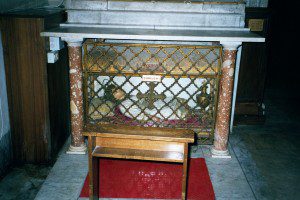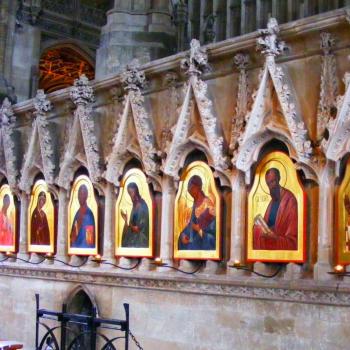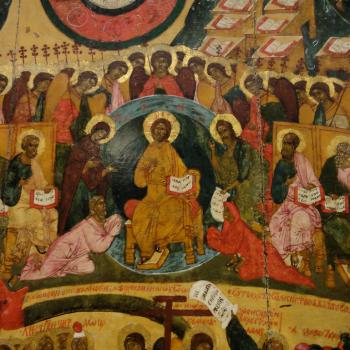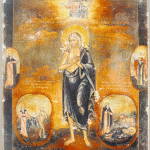While we can read about many who have been killed for the sake of the Christian faith throughout the centuries, nonetheless, there is something unique to the early persecutions of the Christians in the Ante-Nicene era. At the inception of the Christian faith, Christians understood that there was at least a slight risk to becoming Christian, that they could be asked to lay down their lives for Christ. They knew they had to take their faith seriously as they likely knew many who had become confessors or martyrs for Christ. Indeed, it can be said that despite the risks, despite the horrors of martyrdom, these martyrs helped Christianity thrive, attracting attention to the faith, bringing many into its fold. Their presence indicated the seriousness which Christians took their faith. The martyrs were seen as the pillars of the Christian community, whose sacrifice not only helped build up, but actually hold up and preserve the Church.

Certainly, we must not fall for the simple mistake and think that Christians everywhere were constantly being persecuted until the time of Constantine. There were many times and many places where Christians were given relative tolerance and freedom to follow their faith, so long as they did not seem to interfere with the needs of the empire. And yet, there were several significant campaigns which developed against Christians which led to Christians being imprisoned, tortured, and executed. Those who suffered for Christ were remembered and commemorated by faithful. And yet they looked at those who held their faith in such terrible trials with awe. Those who died for the sake of Christ were among the first Christians to receive public veneration by the faithful. Indeed, the faithful wanted to feel connected to the martyrs which can came before them and so they preserved, when possible, their relics. Slowly but surely, with these relics on hand, the Christian faithful were able not only to remember the martyrs, but to feel like they still belonged to the community, that their presence remained in the churches which house their relics.
Scripture was full of the remembrances of the holy men and women of old. The martyrs showed how such holiness continued in the world, that God continued to be at work in and with the Church. Just as saints like the patriarchs Abraham, Isaac and Jacob, or Moses and the prophets, were remembered and believed to be with God interceding for the Church, so the martyrs joined in with that great cloud of witnesses demonstrating the glory of God to all. They, moreover, beckoned us to follow them, putting aside all things which keep us from continuing our spiritual journey to God: “Therefore, since we are surrounded by so great a cloud of witnesses, let us also lay aside every weight, and sin which clings so closely, and let us run with perseverance the race that is set before us” (Heb. 12:1 RSV).
Among the earliest records of the martyrs we can read how Christians preserved as much of the relics of Sts. Ignatius and Polypcarp as they could, saints who themselves had once been disciples of the Apostles. St. Ignatius had been taken to Rome, and fed to the lions – but yet there remained parts of his body which the Christians took to preserve his presence among them:
Then, being immediately thrown in, according to the command of Cæsar given some time ago, the public spectacles being just about to close (for it was then a solemn day, as they deemed it, being that which is called the thirteenth in the Roman tongue, on which the people were wont to assemble in more than ordinary numbers ), he was thus cast to the wild beasts close beside the temple, that so by them the desire of the holy martyr Ignatius should be fulfilled, according to that which is written, “The desire of the righteous is acceptable [to God],” to the effect that he might not be troublesome to any of the brethren by the gathering of his remains, even as he had in his Epistle expressed a wish beforehand that so his end might be. For only the harder portions of his holy remains were left, which were conveyed to Antioch and wrapped in linen, as an inestimable treasure left to the holy Church by the grace which was in the martyr.[1]
St. Ignatius, mauled by lions, did not have his dignity taken away from him; he preserved himself in the faith and so witnessed to all the glory of God. His relics were seen by the rest of the faithful as sacred reminders of the grace which Christ imparted to the Church through the intercession of Ignatius. Paul, in his epistle to the Colossians, had indicated how many could become instruments of grace for the Church:
Now I rejoice in my sufferings for your sake, and in my flesh I complete what is lacking in Christ’s afflictions for the sake of his body, that is, the church, of which I became a minister according to the divine office which was given to me for you, to make the word of God fully known, the mystery hidden for ages and generations but now made manifest to his saints (Col. 1:24-26 RSV).
Therefore the martyrs who suffered for Christ were seen to continue the work of Christ with the Church, helping to incarnate and make real in history the grace established at Calvary. St. Ignatius, a student of the Apostles, had become a bishop and one of their successors, and he showed himself faithful to the task through his death for Christ. Likewise, his friend, and fellow disciple of the Apostles turned bishop, St. Polycarp, also brought much grace into the church through his fidelity to Christ. His body was put to the flames, and yet even then, there remained relics for the faithful to take with them:
The centurion then, seeing the strife excited by the Jews, placed the body in the midst of the fire, and consumed it. Accordingly, we afterwards took up his bones, as being more precious than the most exquisite jewels, and more purified than gold, and deposited them in a fitting place, whither, being gathered together, as opportunity is allowed us, with joy and rejoicing, the Lord shall grant us to celebrate the anniversary of his martyrdom, both in memory of those who have already finished their course, and for the exercising and preparation of those yet to walk in their steps.[2]
The martyrs therefore continued to bring Christ’s grace into the Church. They not only lived in fidelity to Christ, they died in and with him. Their unity with Christ allowed them to be seen as mediators of Christ’s grace, their shed blood mingling with his, bringing forth grace after grace to the faithful. Origen, in his Exhortation to Martyrdom, expressed this by saying to those who were about to die for Christ:
And perhaps just as we have been redeemed by the precious blood of Jesus, who received the name above every name (cf. 1 Pet. 1:19; Rev. 5:9; Phil. 2:9), so some will be redeemed by the previous blood of the martyrs, since they too have been exalted beyond the exaltation of those who were righteous but did not become martyrs. [3]
But not everyone was capable of such fidelity. When challenged, many abandoned the faith, in whole or in part. Sometimes it was something simple as a sacrifice to Caesar which was enough to let a Christian live; at other times, it required verbal repudiation of Christ; sometimes those who lapsed did so with their whole hearts, turning apostate, while others more or less fell under torture and wanted to find their way back to communion. Those among the lapsed who in their hearts wanted to remain faithful to Christ often were told they would have to live the rest of their life in penance, and possibly only at the end of their days they would be allowed peace with the Church and receive final communion. It was a harsh penalty, and yet some even wanted to reject that possibility, and say if anyone lapsed, there was no any possibility of forgiveness, that those who denounced Christ, even if under duress, we apostates who could find no peace within the Church. Among those who favored lighter penances for the lapsed were many of those who became martyrs themselves – they who, on their way to death, knew the challenges and hardships they were facing, often asked for forgiveness for those who were weak. We can read of letters written by those on their way to martyrdom seeking such restoration of the lapsed having a positive effect with their request being granted. Martyrs interceded for repentant sinners and the intercession was able to bring many back into communion. The key was that they had to be penitent – those who wanted restoration to communion had to accept their failing was worthy of condemnation, but if they did, then they could accept the mercy the martyrs established for them and be restored to communion.












